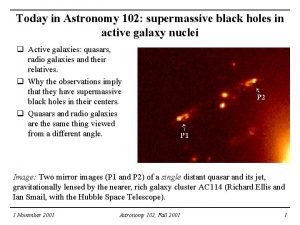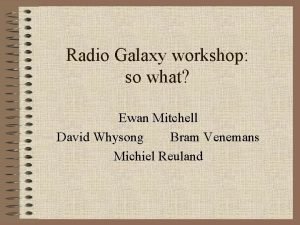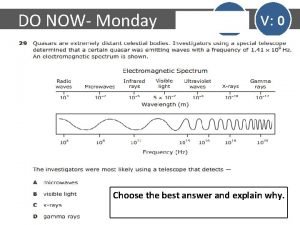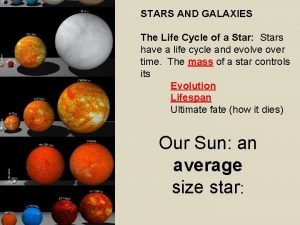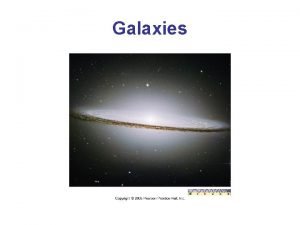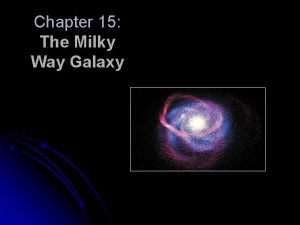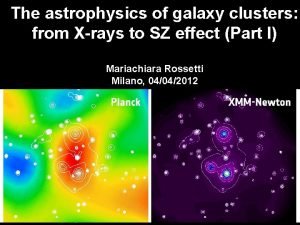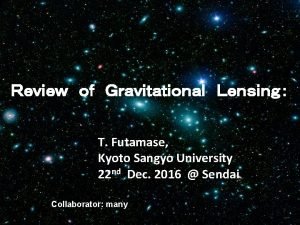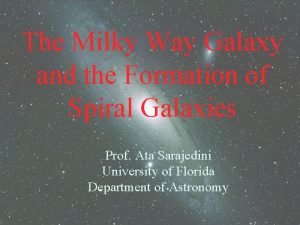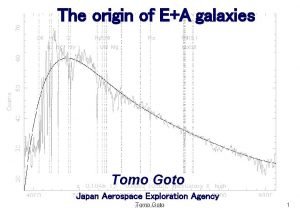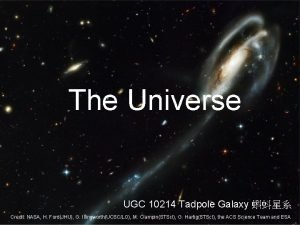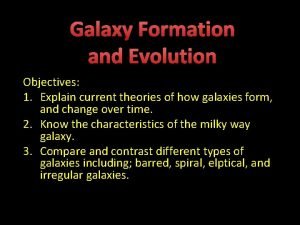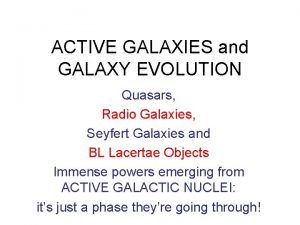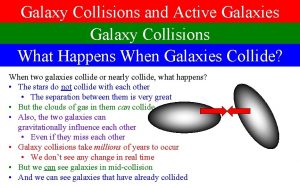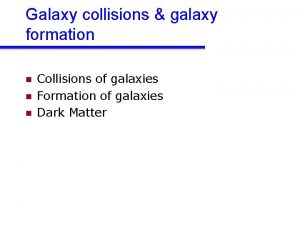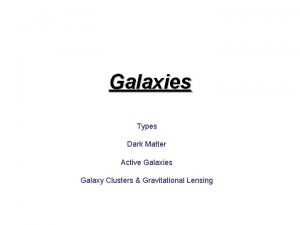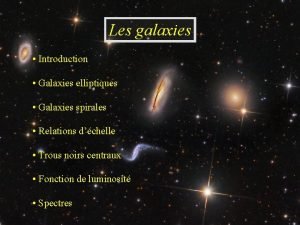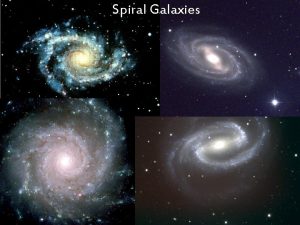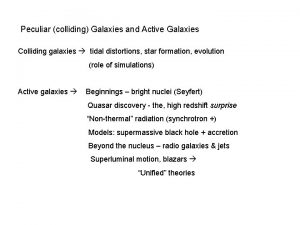Radio Galaxies Part 2 A prototypical radio galaxy



































- Slides: 35

Radio Galaxies Part 2

A prototypical radio galaxy Lobes Hot-spots Core Jets § Any size: from pc to Mpc § First order similar radio morphology (but differences depending on radio power, optical luminosity & orientation) § Typical radio power 1023 to 1028 W/Hz

…. but radio galaxies are not all the same! The morphology of a radio galaxy may depend on different parameters: - radio power (related to the power of the AGN? ) - orientation of the radio emission - intrinsic differences in the (nuclear regions of) host galaxy - environment


The morphology does not depend on size! ~200 kpc ~20 pc

Effects of the interaction with the environment Effects of age

Two main flavors Edge-brightened high radio power Fanaroff and Riley type I and II Edge-darkened lower radio power

FRI Jets FRII Large opening angle low Mach number (but not on small scales) Perpendicular to the jet Very collimated high Mach number (relativistic on small scales) Parallel to the jet Hot-spot -- Yes Lobes Plume-like Backflow Spectral index in the Lobes Steeper away from the nucleus Steeper toward the nucleus (from hot-spots) Magnetic Field o The reason(s) for these differences is not completely clear; likely related to the nuclear regions. o Differences are seen also in other wavebands. o Possibly also environment: lower-power radio galaxies tend to be in clusters

Radio jets Two flavors also for the jets: § supersonic and highly collimated § subsonic with entrainment This can explain the presence of hot-spots and the collimation of the jets.

Simulations of an high Mach number radio jet (velocity of the plasma >> sound speed) Movie M = 10 Movie hot-spot

What makes the difference? Well known dichotomy: low vs high power radio galaxies Differences not only in the radio WHY? Intrinsic differences in the nuclear regions? Accretion occurring at low rate and/or radiative efficiency? No thick tori?


Also important: the resolution of the observations!

Importance of observations at different resolution

M 87 radio emission at different frequencies and resolutions

Often the radio emission is more symmetric on the large scale and asymmetric on the small scale The core is defined based on the spectral index: flat ( ~ 0) [to find which component is the radio core is not always easy: free-free absorption can core complicate the story!]

What are the characteristics of the jets close to the AGN?

Superluminal motions Discovered (around 1970 -80) in powerful radio galaxies and quasars: Ø apparent change (on the VLBI scale) in the structure of some sources during a period of few months. Ø the velocities appear superluminal Ø the components of the velocities and direction remain constant Ø there are no observed “contractions” Ø a flux outburst seems to be associated with the appearance of new components Case of 3 C 273 (quasar) apparent velocity ~10 c

These projection effects explain: § the apparent superluminal motion § the asymmetry between the two jets, also the flux of the approaching and receding components are affected by projection These are among the methods used to find out the orientation of a source

Not all the jets are superluminal VLBI observations of Centaurus A (between 1991 and 1996) Apparent motion subluminal speed ~ 0. 1 c However this does not seem to be characteristics common to all lower power (Fanaroff-Riley I) radio galaxies

3 C 120 Apparent motion of the components between 4 and 6 c but very complex.

§ The structure can be complicated, perhaps from the interaction with the inter-stellar medium § New components can be seen to appear

Going very close to the BH to see how the collimation of the jet works. 43 GHz VLBI rapid broadening of the jet opening angle as the core is approached on scale below 1 mas (0. 1 pc). ~ 1 mas = 0. 071 pc M 87 The jet does not seem to reach a complete collimation until a distance of many tens of Schwarzschild radii (escape velocity = c) jet emanating from the accretion disk, not yet collimated

Optical Jets Ø some radio jets have an optical counter-part Optical jet in M 87 (NGC 4486 in Virgo) Ø few more cases found by HST (high resolution is needed) Ø the more the jet is “beamed” toward us the more is likely we see the optical part Origin of the optical emission: likely an extension of the synchrotron spectrum. Lifetime of the electrons very short Acceleration mechanisms need to be present.

Jets in optical and X-ray M 87 Radio Optical X-ray optical X-ray + optical contours q The new X-ray satellite Chandra has shown that many radio jet have also an X-ray counterpart

Almost identical morphology from the radio to X-ray band: the optical, UV and X-ray data (and spectral indices) are consistent with synchrotron emission The electrons must have high (107) and very short life-time (<<yrs) Other possibility : inverse Compton effect Relativistic electrons in a radiation field. Because of the interaction with the photons, the electrons loose energy while the outcome are photons with higher energy. This interaction can take place between the relativistic electron producing the radio emission and either the radio photons or the photons from the cosmic micro-wave background.

pink = radio blue = X-ray Radio and X-ray of the jet in Centaurus A Very detailed image, scale of the arcsec (~18 pc). Small offset between the radio and X-ray emission. The X-ray trace the regions where the electrons with high are accelerated NOW.

An other well studied case. 3 C 273 (quasar) HST, Chandra, Merlin o Also radio hot-spots are now found to have optical and X-ray counter-parts

A look at the nuclear regions Many indications that the view of the central regions is “orientation dependent: § superluminal motion of the jets § broad optical lines § free-free absorption

Evidence for a circum-nuclear disk/torus Seyfert galaxy NGC 4258 (from water masers) § Evidence of absorption from the X-ray spectra (column density above 1024 cm-2) § Evidence of obscuring “torus” from the optical broad line observed in polarized light in narrow-line radio galaxies

Presence of ionized gas The inner edge of the “torus” (<0. 3 pc) is likely to be completely ionized from the radiation from the AGN. The presence of this ionized medium will cause “free-free” absorption of the radio emission from the nuclear radio components. This effect is prominent at longer wavelengths. Component that “appears” only at high frequency (absorbed at lower frequencies) REAL NUCLEUS!? !

Neutral hydrogen in the nuclear regions HST image From the absorption, the column density of the neutral hydrogen can be derived. Typical numbers are 1020 to 1021 cm-2 VLBI data

Structure of the circumnuclear torus ß 1946+708 Mrk 231

Nuclear dust/gas disks very common in radio galaxies (as we will see tomorrow!)

These characteristics (different morphologies, superluminal motions, presence of nuclear tori etc. ) are extremely important when we will try to “unify” different type of AGN. A key parameter is the orientation of the jets with respect to the line-of-sight.
 How big is the galaxy
How big is the galaxy Radio galaxy
Radio galaxy Radio galaxy
Radio galaxy What are galaxies
What are galaxies The electromagnetic spectrum includes
The electromagnetic spectrum includes Type of galaxy
Type of galaxy Tipus de galaxies
Tipus de galaxies The pity relation for an adiabatic expansion is
The pity relation for an adiabatic expansion is Brainpop galaxies quiz answers
Brainpop galaxies quiz answers Life cycle of galaxies
Life cycle of galaxies Evolution of galaxies
Evolution of galaxies Critical density
Critical density 4 types of galaxies
4 types of galaxies Elliptical galaxies facts
Elliptical galaxies facts Billions of galaxies
Billions of galaxies Chapter 30 galaxies and the universe
Chapter 30 galaxies and the universe How are galaxies classified? *
How are galaxies classified? * Th eirregulars
Th eirregulars Galaxies lesson plan
Galaxies lesson plan Galaxy clusters
Galaxy clusters Galaxy loght
Galaxy loght Closest galaxy to milky way
Closest galaxy to milky way Classification
Classification Galaxy einet
Galaxy einet Galaxy clusters
Galaxy clusters Tomo goto
Tomo goto Huge collections of stars
Huge collections of stars Article galaxy scholar
Article galaxy scholar Solar system science olympiad
Solar system science olympiad Jhu
Jhu Galaxy questions
Galaxy questions Galaxy clusters
Galaxy clusters Galaxy medical products
Galaxy medical products Steve's galaxy (legacy)
Steve's galaxy (legacy) Flight data recorder
Flight data recorder Irregular galaxy
Irregular galaxy

